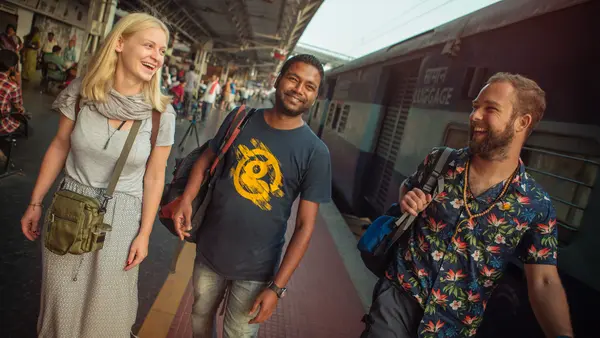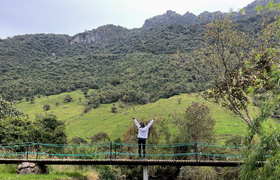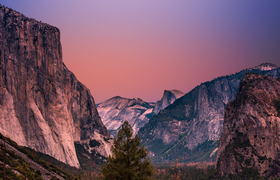
All aboard! Your guide to train travel in India
Hop aboard and discover India's vibrant cities and peaceful countryside the way they are meant to be seen — by train
As you crisscross India on its extensive railway network, you witness stunning landscapes unfold, connect with local people, and create memories that will last a lifetime. Whether you're a seasoned traveller or a first-time visitor, navigating the world of Indian railways can seem daunting, but fear not. This ultimate guide on train travel in India takes you through what to expect on your trip.
What is rail travel like in India?
Train travel in India is an experience in itself. It’s a window into the soul of the country, offering glimpses of daily life, vibrant interactions with fellow passengers, and ever-changing scenery of the best places to visit in India, ranging from bustling cityscapes to serene rural vistas. The rhythmic clatter of the wheels on the tracks, the chaiwalas (tea sellers) making their way through the carriages, the lively chatter of conversations — it all contributes to a unique and eye-opening atmosphere. Imagine waking up to the golden hues of sunrise painting the Rajasthani desert or watching mist-covered mountains glide past your window in the Himalayas. Picture sharing stories and laughter with locals over a cup of steaming chai and savouring Indian street food delicacies offered by vendors at bustling railway stations.

How to book India train tickets online
Booking train tickets in India can seem a little complex at first, but with the right information, it becomes a straightforward process. The most convenient way to book train tickets in India is through the official website of the Indian Railway Catering and Tourism Corporation (IRCTC). Once registered, you can search for trains based on your origin and destination stations, travel dates, and preferred class of travel.
Tips for booking online train tickets
Plan ahead: Book tickets as far in advance as possible, especially for popular routes and during peak travel seasons. Tickets for most trains open for booking 120 days in advance.
Availability: Ticket availability can fluctuate rapidly. The IRCTC website shows real-time availability, allowing you to see how many seats are available in each class.
Tatkal Tickets: If you need to travel at short notice, try booking Tatkal tickets. These are special quotas of tickets reserved for last-minute travellers, but they come at a premium price, and availability is limited.
Payment: The IRCTC website accepts various online payment methods, including credit and debit cards and net banking.
Booking train tickets at railway stations
You can also book train tickets in India in person at major railway stations. This can be a viable option if you prefer a more personal interaction or if you encounter issues with online booking. However, be prepared for long lines, especially at larger stations.
Tips for booking train tickets at the station
Reservation forms: You need to fill out a reservation form with details of your journey, including train number, date of travel, origin and destination stations, and the names of all passengers.
Identification: You may be required to show identification documents for all passengers.

Booking train tickets through travel agents
Another option is to use a reputable travel agent to book your train tickets in India; however, travel agents might charge a service fee.
Types of trains in India
Indian Railways operates a diverse fleet of trains, each catering to different travel needs and budgets. The longest train route in India stretches more than 4,200km (2,610 mi), connecting Dibrugarh in Assam to Kanyakumari in Tamil Nadu. Choose your train based on how far you're going, your schedule, and your comfort preferences.
Maharajas' Express: A high-end train experience with elegant cabins, fine dining, and heritage-focused routes.
Vande Bharat Express: Semi-high-speed trains offering modern comfort and quicker travel on select routes.
Rajdhani Express: Fast, fully air-conditioned trains connecting Delhi with state capitals, with meals included.
Shatabdi Express: Daytime air-conditioned trains that link major cities; has meals and quick service.
Duronto Express: Long-distance trains with minimal stops, ideal for fast intercity travel.
Express & Mail Trains: The most common long-distance trains, offering both air-conditioned and non-A/C cars with multiple stops.
Passenger Trains: Slower trains connecting smaller towns and rural areas, stopping frequently and offering low fares.
Toy Trains: Narrow-gauge scenic trains like the Darjeeling, Kalka-Shimla, and Matheran Hill Railway routes, known for mountain views and heritage charm.

Classes on Indian railways
Indian trains offer a variety of classes to match different comfort levels and budgets. Not all of these options are available on all journeys, but these classes are the main types.
AC First Class (1A): The most premium option, with spacious two- or four-berth lockable cabins, air-conditioning, bedding, and attentive service. It offers maximum privacy and comfort, and fares are typically on par with domestic flights.
AC 2-Tier (2A): A comfortable class with two-tier sleeping berths, air-conditioning, bedding, and curtains for privacy. It’s quieter and less crowded than cheaper classes, making it ideal for long-distance overnight travel.
AC 3-Tier (3A): Features three-tier berths on each side of the aisle, offering air-conditioning and bedding, but with more passengers per coach. It’s a popular choice for budget-conscious travellers who still want air-conditioned comfort.
AC 3-Tier Economy (3E): Similar to 3A but with more berths per bay and slightly narrower beds. It's a lower-cost A/C option and available on select trains, balancing comfort with affordability.
First Class (FC): A non-A/C class with wider berths and more space than Sleeper Class. It's less common now, but it's still found on some older trains, offering a comfortable ride at a midrange price.
Sleeper Class (SL): The most widely used class, with three-tier non-AC berths and basic facilities. It’s economical but can be crowded, especially during peak travel times. Bedding isn’t provided, so bring your own.
AC Chair Car (CC): Offers air-conditioned seating with cushioned, reclining chairs, typically used on daytime trains. It’s a good option for shorter trips with added comfort.
Second Sitting (2S): The most basic class with non-reclining seats and no air-conditioning. It’s affordable and often used for short distances, but this class can be crowded and lacks reserved seating on many routes.

Safety and train travel in India
Train travel in India is generally safe, but a few precautions can help ensure a smooth journey. Avoid accepting food or drinks from strangers, and buy only from official vendors. Solo travellers may prefer AC First Class or AC 2-Tier for added security. Share your travel plans with family or friends, keep emergency contacts handy, and follow local advisories. Use official booking platforms and be cautious at stations, particularly at night. Dressing modestly and respecting local customs is also recommended.
Train routes and stops in India
India’s railways span the entire subcontinent, offering travellers a front-row seat to its diverse geography, culture, and heritage. These memorable routes highlight the country’s variety and depth.
Delhi to Kathmandu
Although there is no direct train from Delhi to Kathmandu, Nepal, you can travel much of the way by rail through northern India, heading toward towns near the Nepalese border. The journey passes through the fertile plains of Uttar Pradesh and offers views of rural life, farmlands, and eventually the distant foothills of the Himalayas. It’s a cross-border adventure that blends vibrant local culture with changing natural scenery and stunning wildlife.

Experience it for yourself on: Delhi to Kathmandu: River Walks & Epic Wildlife
Delhi to Goa
Travelling from Delhi to Goa by train covers a wide stretch of the country, moving from the historic and political capital through central India’s varied terrain to the palm-lined shores of the Arabian Sea. For a particularly scenic ride along the western coast, the Mandovi Express, which travels via the Konkan Railway, is a popular choice for its lush views, tunnels, and seaside glimpses. This route showcases the diversity of India’s environment, with shifts in architecture, cuisine, and climate as you make your way south to Goa’s relaxed, beachy atmosphere.
Experience it for yourself on: Uncover India: High Deserts & Markets
Rajasthan to Varanasi
This eastbound journey takes you from the royal cities of Rajasthan — Jaipur, Jodhpur, and Udaipur — to the spiritual heart of India, Varanasi. Along the way, you pass desert regions, bustling towns, and the rich cultural landscapes of northern India. The route offers a striking contrast between the grand forts and palaces of the west and the sacred rituals and riverside traditions of the east.

Experience it for yourself on: Rajasthan & Varanasi — Ancient Temples & the Taj Mahal
Delhi to Kochi
This route weaves together some of India’s most iconic historical sites. Starting in Delhi, you can make stops in Agra to take photos of the Taj Mahal and explore the ruins of Hampi, once a thriving capital of the Vijayanagara Empire. From there, the train takes you through lush southern landscapes before arriving in Kochi, a port city known for its colonial influence, backwaters, and cultural blend.
Experience it for yourself on: Delhi to Kochi: Hampi Ruins & The Taj Mahal
Goa to Kochi
Southern India is home to a wealth of ancient temples, UNESCO World Heritage sites, and peaceful natural settings. Train routes connecting cities in Tamil Nadu or Karnataka to Kerala pass through areas rich in history and spirituality. For travellers exploring southern India, the Island Express connects key destinations like Bengaluru (Bangalore) and Kanyakumari, offering a comfortable way to traverse the region. As you head toward the coast, the journey transitions into Kerala’s calm rhythm, with stops near tranquil beaches, tea-covered hills, and winding backwaters.
Experience it for yourself on: India: Ancient Ruins & Kerala Beaches




